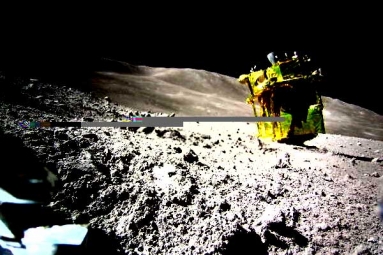
(Image source from: indino.in)
The launch of an Indian Geosynchronous Satellite Launch Vehicle with a geostationary Earth- imaging satellite which has been planned to liftoff on Thursday has now been postponed due to technical reasons, as announced by space agency of India.
The reason for the postponement of the launch has not been identified by the Indian Space Research Organization but it has been announced by the Indian Space Research Organization that the revised date for the launch would be informed in the due course.
The GSLV Mk.2 launcher has been scheduled for liftoff at 12213 GMT (7:13 a.m. EST) Thursday and the launch was supposed to be taking place from the Satish Dhawan Space Center on the east coast of India.
After it takes off, the 169- foot- tall which is 51.7 meter GSLV Mk.2 launcher is said to be heading towards the southeast from the space center over the Bay of Bengal and it has also been said that within less that 20 minutes later, the GSLV’s third stage will be deploying Geo Imaging Satellite 1 of India or GISAT 1, into an elliptical geostationary transfer orbit.
The GSLV mission which has been designed GSLV-F10 is said to be the first space launch of India of the year. The launch vehicle which is set to launch with GISAT 1 is said to feature an enlarged 13.1- foot which is 4 meter in diameter composite nose shroud which is said to give an additional volume for the payloads in the GSLV Mk.2.
The GISAT 1 spacecraft which is said to be around 5,000 pound will be using its on- board propulsion system in order to reach a circular geostationary orbit which is said to be more than 22,000 miles over the equator. The satellites present in the geostationary orbit would fly around the Earth at the same rate as the rotation of the planet and it gives a constant view of the same part of the planet Earth to the spacecraft.
Most of the Earth observation satellites is said to orbit at much lower altitudes which is said to be typically a few hundred miles above the planet Earth but is said to narrow coverage swaths.
It has said that the GISAT 1 would be placed at 85.5 degrees east longitude in the geostationary orbit and it is said to provide the views of the subcontinent of India and the neighboring ocean regions 24 hours per day.
Although the satellites that monitor the weather also fly in the geostationary orbit, but GISAT 1 is said to carry a powerful Earth- viewing telescope which would provide a sharper imagery than a typical meteorological observatory.
The three color and the hyperspectral sensors is said to take the visible, near- infrared and the shortwave infrared images as the hyperspectral detectors are said to be designed in order to register the details about the landscapes and the oceans such as vegetation type, plant health, quality of the water and also the other environmental factors.
The Indian Space Research Organization has said that the imagery from GISAT 1 would be made use for a host of applications which include monitoring of the crop at the regional as well as at the nationals levels, drought progression and assessment, monitoring of the dust and various other applications.
The telescope of GISAT 1 would be used to scan in east- west and the north- south motions and it would collect the images with a ground resolution as sharp as about 137 feet which is said to be 42 meters.
By Shrithika Kushangi









